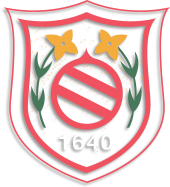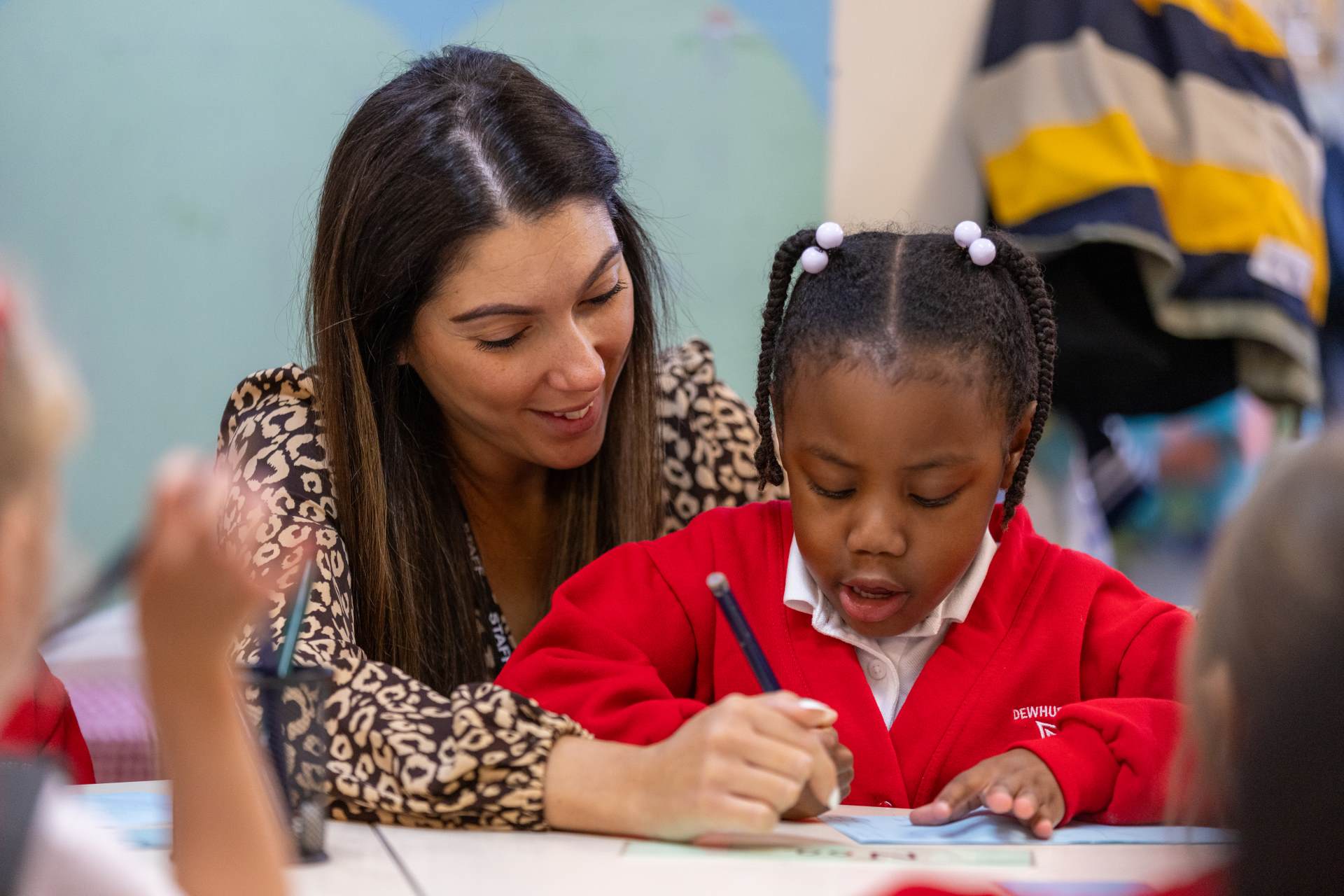English
Year 5 and 6 Spelling List Common Exception Words
Year 3 and 4 Spelling List Common Exception WordsYear 2 Spelling List Common Exception Words
Year 1 Spelling List Common Exception Words
At Dewhurst St Mary, we recognise the important place that English has in education and society. We strive to provide high quality education in English so that pupils can speak and write fluently in order to communicate their thoughts and feelings to others and through their listening and reading, others can communicate with them. Through reading in particular, pupils have a chance to develop culturally, emotionally, intellectually, socially and spiritually through carefully chosen texts. Reading also allows pupils to expand their knowledge and build on what they already know. The skills of language are essential to participating fully as a member of society.
We equip pupils with the ability to use spoken and written words effectively, and to develop an enjoyment of reading. We ensure that all of our pupils:
- read easily, fluently and with good understanding
- develop the habit of reading widely and often, for both pleasure and information
- acquire a wide vocabulary, an understanding of grammar and knowledge of conventions for reading, writing and spoken language
- appreciate our rich and varied literary heritage
- write clearly, accurately and coherently, adapting their language and style in and for a range of contexts, purposes and audiences
- use discussion in order to learn; elaborating and explaining their thinking clearly
- are competent in speaking and listening, making formal presentations
- can participate in a debate
How we teach children to read:
Pupils start learning to read and write by learning how to blend and segment sounds (phonemes) we teach this using the Ruth Miskins ‘Read Write Inc’ strategy.
In Reception and Key Stage 1 we teach children to read using our synthetic phonics programme ‘Read Write Inc’. We systematically teach the sounds using the RWI core story books which contain red sight words and words which can be blended phonetically . We then send home the corresponding book or flashcards which will allow your child the opportunity to consolidate their learning and accelerate progress. This book should be prioritised and should be read lots of times to ensure your child becomes fluent when reading.
What books will my child bring home?
How we teach reading and writing to pupils in Rec and Year 1 ;
A Parents Guide to How We Teach Phonics
RWI Book Bag Books (224 downloads)
We teach your child to read using our Synthetic Phonics Programme READ WRITE INC. (RWI)
To learn all about it click the link:
Read Write Inc. is a popular phonics scheme. Like all phonics schemes, it teaches children the sounds in English, the letters that represent them, and how to form the letters when writing. Read Write Inc. Phonics includes reading books written using only the letters they have learnt at each level (and a small number of separately taught tricky words). The children will quickly feel confident and successful.
You will find a useful phonics audio guide to all these sounds in our Sound Pronunciation Guide video. It is really important to say the sounds clearly to help your child learn them. We say ‘mmmm’ not ‘muh’ and ‘lllll’ not ‘luh’ when teaching the sounds. This really helps children when they learn to blend sounds together to read words.
What is Fred Talk?
If your child’s school is using Read Write Inc. Phonics, teachers will introduce your child to a toy frog called Fred once he or she is ready to start reading words.
Fred can only say the sounds in a word and needs your child to help him read the word. Fred will say the sounds and children will work out the word. For example, Fred will say the sounds c–a–t, and children will say the word cat. This is Fred Talk: sounding out the word.
We teach set 1 and set 2 sounds in reception and complete this with set 3 sounds in year 1. Phonics attainment is assessed every six weeks to inform our teaching and we do a National Phonics Screening test in the Summer term of Year 1 and this is compared to other pupils in schools nationally. Pupils who do not meet national expectations at the end of Year 1 receive intervention as they move into year 2 and beyond.
As we move further throughout the school we focus on fluency and comprehension. We look at the skills of inference and look at how language has been used to convey imagery.
At Dewhurst St Mary we encourage out children to read every night with an adult at home, this is in addition to Guided Reading sessions in school and individual reading with adults in school.
We use a wide range of reading schemes for teaching reading including; Oxford Reading Tree, Phonics Bug, Collins Big Cat , Rigby Star, Project X as well as Read Write Inc.
How we teach spelling;
www.gov.uk/government/uploads/system/uploads/attachment_data/file/239784/English_Appendix_1_-_Spelling.pdf In year 2-6 we follow the ‘Read Write Inc’ Spelling Scheme which teaches spelling patterns and the Common Exception words which are published by the DfE. Some children may need additional intervention if they haven’t met the expectations at the end of Key Stage 1. In Upper Key Stage 2, these materials are supplemented through the use of the Ninja Spelling Scheme which supports the children’s existing phonic and spelling knowledge using more age appropriate resources.
Writing
We offer children an ambitious curriculum to teach writing across all year groups, following a clear structure in our approach to writing. Strategies include demonstration, modelling, explanation, questioning and discussion, alongside the incorporation of a wide range of genres in a varied number of forms such as the written word, film and pictorial stimuli.
Our intent is to guide children to be imaginative, creative, independent, inquisitive, inquiring and confident writers. To provide them with a range of writing skills and strategies to enable them to write confidently with comprehension, cohesion and enjoyment for a range of purposes, in a variety of contexts and for different audiences. Through our use of a broad and balanced curriculum we ensure no opportunity is missed to foster an enjoyment of writing amongst pupils and a recognition of its value, by setting work that is challenging, inspirational and motivating, helping them to develop a positive and enthusiastic attitude towards writing, which will nurture a life-long love of writing. Through careful planning we provide children with opportunities to explore a variety of different genres and to be exposed regularly to high quality texts, providing a model for pupils to aspire to.
To ensure children have a clear understanding of the writing process: plan, draft, revise and edit their own work, and learn how to self and peer assess against the success criteria. Children develop their ability to self-assess by reflecting on the quality of their writing, teachers encourage them to construct informed opinions and implement strategies to improve their own work.
Poetry
Weekly poetry sessions actively encourage our children to perform poetry in groups or as individuals and recite poems by heart. If poetry is not given a voice, if it just stays on the page as a printed object, then it is not going to come alive for most children. The best way to help children to become comfortable with poetry is to make sure they hear a wide range of poetry as often as possible.
In all year groups, the aim is not to produce written, analytical response to poetry but to enable our pupils to talk, discuss and explain verbally, using specific poetry vocabulary (more in depth analysing outcomes/suggestions appear from Year 2 onwards) We teach that different poetic forms use different language features. It is important that children do not just recognise language features, such as simile, but also discuss the impact, their response and interpretation. Key features of poetry include:
- sound effects – repetition, alliteration, onomatopoeia, rhythm, rhyme;
- visual effects – simile (like/as), personification, metaphor;
- selection of powerful nouns, adjectives and verbs;
- surprising word combinations; · use of repetition and repeated patterns for effect.
Poems by poets the children become familiar with may become a catalyst for writing poetry. This can be done as a whole class, following a simple pattern as a scaffold. As children grow in confidence these may become a stepping stone to their own independent writing. The key forms for children’s writing are:
- collage or list poem · free verse · shape poems (free verse in a shape) · short patterned poems, for example, haiku, cinquain, kennings · borrow or invent own pattern, for example, pairs of lines · simple rhyming form, for example, rap.
Once all the ‘mechanics’ have been thought about it is also vital to think about appreciation. How does the poem make you feel as a reader? What do you think of the poem?
Would you like to perform it?
Focus Poets
EYFS: Nursery Rhymes
Year 1: James Carter
Year 2: Allan Ahlberg and Julia Donaldson
Year 3: Michael Rosen and Grace Nichols
Year 4: Roger McGough
Year 5: Benjamin Zephaniah
Year 6: Joseph Coelho ( Children’s Laurette 2022-2024)
Handwriting
There are regular timetabled slots for handwriting to ensure that children build up their handwriting skills every day. We make the physical process of writing – handwriting – enjoyable from the start, so children see themselves as ‘writers’. We use mnemonics – memory pictures – to help children visualise the letter or join before they write it down. Children need to practise handwriting under the guidance of a teacher so they do not develop habits that will be difficult to undo later.
Children will find they need to use an un-joined style for some writing tasks e.g labels, diagrams or data. The two different styles are equal; joined writing should not be presented ‘better’ than un-joined. Pupils should be using joined handwriting throughout their independent writing, across subjects. Handwriting should continue to be taught, with the aim of increasing the fluency with which pupils are able to write down what they want to say. This, in turn, will support their composition and spelling. At times, handwriting might be the focus of the task to present a piece or part of a piece of writing for a specific purpose.
Literacy homework and spellings will be undertaken regularly and we encourage children to use their Literacy skills across all subjects and homework tasks. We supplement home-learning with an online literacy based program called Lexia where each pupil can log on and work systematically at their own level. It assesses gaps in their learning and allocates activities for children to practice specific skills.
“The more that you read, the more things you will know. The more that you learn, the more places you’ll go.” Dr Seuss



